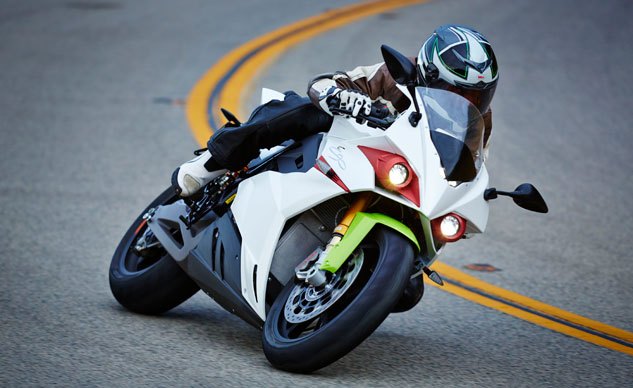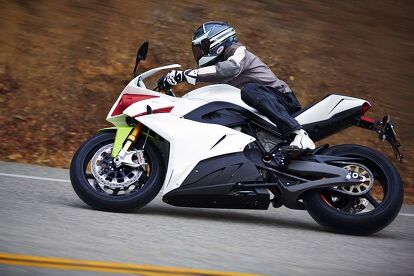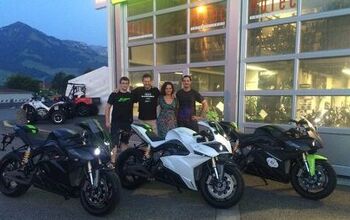2015 Energica Ego Second-Ride Review + Video
After riding the prototype, we test the production Ego on home turf
The world of electric sportbikes just got turned up a notch with the debut of the production version of the Energica Ego. Built in Italy as an adjunct business for a Formula 1 supplier, the Ego brings European style and sophistication to the e-bike market.
2015 Energica Ego
| Engine | 18.5/20 |
| Suspension/Handling | 12.0/15 |
| Transmission/Clutch | 10.0/10 |
| Brakes | 9.5/10 |
| Instruments/Controls | 5.0/5 |
| Ergonomics/Comfort | 6.5/10 |
| Appearance/Quality | 9.5/10 |
| Desirability | 9.0/10 |
| Value | 3.0/10 |
| Overall Score | 83/100 |
You may recall we had a chance to throw a leg over the Ego prototype last year in Italy, and we were impressed by how production-ready the Italian e-sportbike performed. With its oil-cooled, permanent-magnet AC motor factory-rated at 134 horsepower and 144 ft-lb of torque, it easily trumped anything from e-bike leaders Zero and Brammo, and its claim of a lofty 150-mph top speed almost seemed like it might be feasible.
2015 Energica Ego Review – First Ride
We’re still unable to verify the Ego’s top speed, but a recent ride on the production Ego solidified our initial impressions about Energica’s platform and performance. Riding on familiar roads this time around, we were able to double our impressions by bringing along one of our riding buddies, Daniel Schoenewald, for the ride.
What’s New
The transition from prototype to production has seen several changes and updates to the Ego. Here’s a quick rundown of the major tweaks.
- Completely new electronics and Vehicle Control Unit.
- New, 4.3-inch full-color TFT instrumentation.
- Four ride modes: Standard, Sport, Eco and Rain.
- A choice of three levels of regenerative braking and the ability to switch it off.
- Reverse mode: Handy if parking on inclined surfaces; functions only at a crawl speed.
- New engine cases built of cast aluminum rather than the billet pieces on the prototype.
- Curb weight increased by 22 pounds due to the engine castings and addition of an onboard charger.
- Swingarm made of a single aluminum casting. Wheelbase increases by 5mm to 57.9 inches.
- New battery case to ensure waterproofness.
- Front brake rotor diameters go up by 10mm to a large 330mm size.
- The 240mm rear disc is larger by 20mm.
- Bosch ABS will be standard equipment, but the system is undergoing calibration and wasn’t fitted to our test bikes.
Top Of The Range, First Off The Line
The first 45 Egos to be produced will be a high-spec version called the Ego 45 Limited Edition. Each will be individually numbered with a plaque mounted on the upper triple clamp. Electronic upgrades include GPS integration, Bluetooth connectivity and a smartphone app.
Mechanical bits raised to a higher standard are the suspension and wheels. An Ohlins FGRT NIX-30 cartridge fork leads the way, while a TTX shock holds up the rear. Wheels are OZ forged-aluminum hoops instead of the cast wheels on the base version. It is also supplied with a 20-kW DC fast-charger, an extra-cost option on the regular Ego.
The Ego 45’s bodywork is lightweight carbon fiber instead of the injection-molded plastic on the base model. It’s also graced by a smattering of 3D-printed components from Energica’s parent company, the CRP Group, a noted supplier to several Formula 1 teams.
Pretty much every limited-edition motorcycle from Italy has been expensive, and the Ego 45 continues that trend. It retails at a whopping $68,000, twice the price of the base model. If that seems too steep, consider that Energica is sweetening the deal with an Italian Lowell watch crafted from wood and individually numbered to match the number on your Ego 45.
Critical Numbers
EV batteries are expensive, and high-capacity batteries (11.7 kilowatt/hour in the Ego) are heavy. Hence, the base-model Ego is tropospherically priced at $34,000 and scales in at a hefty 584 pounds. Below are Energica-supplied numbers for range and recharging times.
| Range | Recharging |
|---|---|
| 190 km at 60 kph (118 mi. at 37 mph) | Zero to 100% via 110-volt outlet: 8 hours |
| 150 km at 80 kph (93 mi. at 50 mph) | Zero to 100% via J1772 220-volt DC charger: 3.5 hours |
| 100 km at 100 kph (62 mi. at 62 mph) | Zero to 85% via Mode-4 DC supercharger: 30 minutes. |
| 50 km (31 mi.) when ridden on a racetrack | Battery is said to be good for 1200 cycles before it drops below 80% capacity. |
Charged Up And Ready To Roll
Our ride was set in the twists and turns of the Santa Monica Mountains bordering the tony seaside city of Malibu, Calif. Schoenewald and I were let loose on a standard Ego (but with carbon-fiber bodywork) and the limited-production Ego 45 in its Matte Pearl White. I was quick to call dibs on the exotic Ego 45 bearing the mega-exclusive 00/45 badge.
Before taking off, Energica’s Chief Technical Officer, Giampiero Testoni, walked us through the new electronics and brilliantly vivid TFT color instrumentation. We decided to start off in the Standard ride mode and with regenerative braking in its medium setting.
An electric motor’s power delivery can be anything its engineers program into its motor controller, so a rider is never quite sure what kind of response a twist of an e-bike “throttle” will deliver. But in the Ego’s case, twisting the grip spits forth a completely intuitive response that allowed us to smoothly accelerate out of the parking lot and onto the open road.
My next test was to see how hard the Ego accelerated with the twistgrip spun to its stop. While it pulled with the supernatural response of a high-performance electric motor and an unending powerband, the thrust didn’t feel as enormous as the prototype I rode in Italy. I decided to switch it to Sport mode at the next opportunity and was rewarded with serious levels of oomph.
A few other button pushes toggled the regen braking up to its highest setting. I was wary of using the higher level of regen because I feared it would add an unnatural amount of braking force, but I couldn’t have been more impressed. Fully shutting the throttle produced a level of force very similar to that delivered from an internal-combustion engine on the overrun, so it felt entirely natural. And, just as important to smooth riding, there is an easily ascertained neutral-throttle area just behind the closed-throttle point that allows the Ego to coast without adding engine/motor braking. This well-tuned setup is ideal and feels entirely natural.
As with the prototype Ego (and the recently hyped Harley-Davidson LiveWire), the Energica is definitely not a silent motorcycle. The straight-cut transmission gears whine like something out of science-fiction movie and are a visceral audio accompaniment to a sporty ride.
Harley-Davidson LiveWire First Ride
Video of the LiveWire and interviews with execs and engineers
The Ohlins suspension on the Ego 45 was expertly set up and provided a fairly supple ride despite well-controlled damping settings. It worked so well that critiques are non-existent. The suspension on the base Ego (Marzocchi fork, lower-spec Ohlins shock) I sampled later also felt quite good, lacking only some suppleness compared to the Ego 45’s premium dampers.
Brakes, too, are top-shelf items and beyond reproach, with immense power and precise modulation. The only thing lacking is the still-absent ABS system that has delayed the Ego’s full production until April or May next year due to calibration requirements.
When riding the Ego after a petrol-powered sportbike, the first thing you’ll notice is the extra weight, especially when pulling it up off its sidestand. At nearly 600 pounds, there’s no escaping its lardiness. And yet the Ego feels considerably lighter in motion than its specs indicate. The heaviest part of the Ego, the battery, is thankfully mass-centralized between a rider’s legs, and the chassis geometry is quite aggressive, with a steep 23.5-degree rake and a tidy 100mm of trail. The result is a sportbike that responds with a quickness superior to what its weight suggests, but with a heaviness that makes a GSX-R 750 feel like a GP bike.
Agility is also slightly dulled by handlebars placed quite low and at the end of a long reach, something I griped about when I rode the prototype Ego. Bars placed higher and further back toward a rider would impart greater forces to the steering and allow the bike to turn into a corner a bit quicker.
A short trip up Pacific Coast Highway revealed the Ego’s ease of use in urban environments. No clutch to modulate, no gears to shift, and bottomless power available the instant your wrist rotates. Also, the Ego’s LED headlights are dazzling and impossible to ignore, and the bike looks impressively snazzy as it whirs down the road.
Post-Ride Numbers
After logging 46 miles on both bikes, the standard Ego had 34% of charge remaining in the battery. We had 27% charge remaining on the Ego 45, to which I blame my greedy throttle hand. I predict about 90 miles could be wrung out of the Ego if it wasn’t ridden like it was stolen and you stayed off the highway,
“Riding it was a good experience,” Schoenewald opined. “It has that great speed and rush that we look for from a motorcycle.”
So, the Ego is a thrilling new take on a sportbike, delivering a sporty riding experience that has the potential to warp your mind of what you previously thought was possible from a motorcycle. It looks sexy, goes like stink and redefines the term high-tech.
But, like every electric motorcycle we’ve sampled, the price tag will give pause to any prospective buyer. The Ego’s $34k MSRP could buy a sweet petrol-powered motorcycle – or five mediocre ones – that can be refueled in minutes at locations scattered on street corners all across the country.
“It’s a great bike, but I don’t think it fits what I’m looking for,” Schoenewald said, adding its price, heaviness and range limitations rule it out of consideration. “I’m just not ready for it.”
2012 Lightning Motorcycles Exclusive First Ride + Video
The development of electric motorcycles is blossoming into some really exciting forms, such as this wonderful Ego. But the e-bike bugaboo issues of range and price assure they remain a niche market, at least at present. The Ego earns high marks in every category of our scorecard but Value, where its finite range is factored in with its eye-squinting price.
The Ego’s allure is sure to be strong among those with deep pockets and extra motorcycles in their garage, but the Italian superbike is out of practical reach for the proletariat.
More information can be found at http://www.energicasuperbike.com/
+ Highs
- Immaculate throttle response and control
- Power whenever and wherever
- Extremely high level of exotica
– Sighs
- Price tag looks like a W-2 form
- Range anxiety
- Tips scales too heavily
2015 Energica Ego Specifications | |
|---|---|
| Motor | Oil-cooled, permanent-magnet AC |
| Horsepower | 100kW (134 hp) from 4900 rpm to 10,500 rpm |
| Torque | 195 Nm (144 ft-lb) from 0 to 4700 rpm |
| Transmission | Single speed, with reverse |
| Final drive | #525 o-ring chain |
| Frame | Tubular trellis |
| Front suspension | Fully adjustable Marzocchi 43mm inverted fork (Ohlins 43mm inverted fork on Ego 45) |
| Rear suspension | Fully adjustable Ohlins single shock |
| Front brakes | Brembo 4-piston radial-mount monoblock calipers; 330mm dual discs |
| Rear brake | Brembo 2-piston caliper, single 240mm disc |
| Front tire | 120/70-17 Pirelli Diablo Rosso |
| Rear tire | 180/55-17 Pirelli Diablo Rosso |
| Seat height | 31.9 inches |
| Curb weight | 584 lbs |
| Rake | 23.5 degrees |
| Trail | 100mm |
| Wheelbase | 57.9 inches |
| Fuel capacity | 11.7 kW/h battery |
| Electronics | Ride modes, regenerative braking, ABS |
| Colors | Matte White or Matte Pearl White |
| MSRP | $34,000; $68,000 for Ego 45 Limited Edition |
More by Kevin Duke
































































Comments
Join the conversation
Compression braking? A gas engine's "engine braking" is due to VACUUM in the cylinder(s) when the throttle valve is closed-off. It's not compression. In a diesel a compression release mechanism is typically used (such as a Jacob's Brake) since they don't have throttle valves to create the vacuum effect. With a "Jake Brake", the exhaust valve is held open during the compression stroke to prevent the compression energy being transferred back to the crankshaft... anyway I'm no expert but I know "compression braking" is the wrong term to use for engine braking.
I would buy one :)